Toronto Maple Leafs theme by Raymond Regina
Download: TorontoMapleLeafs.p3t

(1 background)
| Toronto Maple Leafs | |
|---|---|
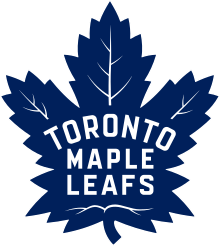 | |
| Conference | Eastern |
| Division | Atlantic |
| Founded | 1917 |
| History | Toronto Arenas 1917–1919 Toronto St. Patricks 1919–1927 Toronto Maple Leafs 1927–present |
| Home arena | Scotiabank Arena |
| City | Toronto, Ontario |
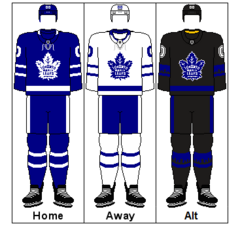 | |
| Team colours | Blue, white[1][2] |
| Media | Sportsnet Ontario TSN4 Sportsnet 590 The Fan TSN Radio 1050 |
| Owner(s) | Maple Leaf Sports & Entertainment Ltd. (Larry Tanenbaum, chairman) |
| General manager | Brad Treliving |
| Head coach | Craig Berube |
| Captain | John Tavares |
| Minor league affiliates | Toronto Marlies (AHL) |
| Stanley Cups | 13 (1917–18, 1921–22, 1931–32, 1941–42, 1944–45, 1946–47, 1947–48, 1948–49, 1950–51, 1961–62, 1962–63, 1963–64, 1966–67) |
| Conference championships | 0 |
| Presidents' Trophy | 0[note 1] |
| Division championships | 6 (1932–33, 1933–34, 1934–35, 1937–38, 1999–2000, 2020–21) |
| Official website | www |
The Toronto Maple Leafs (officially the Toronto Maple Leaf Hockey Club and often referred to as the Leafs) are a professional ice hockey team based in Toronto. The Maple Leafs compete in the National Hockey League (NHL) as a member of the Atlantic Division in the Eastern Conference. The club is owned by Maple Leaf Sports & Entertainment, a company that owns several professional sports teams in the city. The Maple Leafs' broadcasting rights are split between BCE Inc. and Rogers Communications. For the first 14 seasons, the team played its home games at the Mutual Street Arena, before moving to Maple Leaf Gardens in 1931. The Maple Leafs moved to their present home, Scotiabank Arena (originally named Air Canada Centre), in February 1999.
The club was founded in 1917, operating simply as Toronto and known then as the Toronto Arenas. Under new ownership, the team was renamed the Toronto St. Patricks in 1919. In 1927, the franchise was purchased by Conn Smythe and renamed the Maple Leafs. A member of the "Original Six", the club was one of six NHL teams to have endured the period of League retrenchment during the Great Depression. The club has won 13 Stanley Cup championships, second only to the 24 championships of the Montreal Canadiens. The Maple Leafs history includes two recognized dynasties,[broken anchor] from 1947 to 1951; and from 1962 to 1967.[3][4] Winning their last championship in the 1966–67 season, the Maple Leafs' 57-season drought between championships is the longest drought in league history. The Maple Leafs have developed rivalries with five NHL franchises: the Boston Bruins, Buffalo Sabres, Detroit Red Wings, the Montreal Canadiens, and the Ottawa Senators.
The Maple Leafs have retired the use of 13 numbers in honour of 19 players, including the first in professional sports. In addition, several individuals who hold an association with the club have been inducted into the Hockey Hall of Fame. The Maple Leafs are presently affiliated with the Toronto Marlies of the American Hockey League (AHL).
Team history[edit]
| Evolution of the Toronto Maple Leafs |
|---|
| Teams |
| Toronto Pro HC (ind., OPHL) 1906–1909 |
| Toronto Blueshirts (NHA) 1912–1917 |
| Toronto Arenas (NHL) 1917–1919 |
| Toronto St. Patricks (NHL) 1919–1927 |
| Toronto Maple Leafs (NHL) 1927–present |
| Ice hockey portal |
Early years (1917–1927)[edit]
The National Hockey League was formed in 1917 in Montreal by teams formerly belonging to the National Hockey Association (NHA) that had a dispute with Eddie Livingstone, owner of the Toronto Blueshirts. The owners of the other four clubs—the Montreal Canadiens, Montreal Wanderers, Quebec Bulldogs and the Ottawa Senators—wanted to replace Livingstone, but discovered that the NHA constitution did not allow them to simply vote him out of the league.[5] Instead, they opted to create a new league, the NHL, and did not invite Livingstone to join them. They also remained voting members of the NHA, and thus had enough votes to suspend the other league's operations, effectively leaving Livingstone's league with one team.[6]
The NHL had decided that it would operate a four-team circuit, made up of the Canadiens, Montreal Maroons, Ottawa, and one more club in either Quebec City or Toronto. Toronto's inclusion in the NHL's inaugural season was formally announced on November 26, 1917, with concerns over the Bulldogs' financial stability surfacing.[7] The League granted temporary franchise rights to the Arena Company, owners of the Arena Gardens.[8] The NHL granted the Arena responsibility of the Toronto franchise for only the inaugural season, with specific instructions to resolve the dispute with Livingstone or transfer ownership of the Toronto franchise back to the League at the end of the season.[9]

The franchise did not have an official name but was informally called "the Blueshirts" or "the Torontos" by the fans and press.[10] Although the inaugural roster was made up of players leased from the NHA's Toronto Blueshirts, including Harry Cameron and Reg Noble, the Maple Leafs do not claim the Blueshirts' history as their own.[11] During the inaugural season, the club performed the first trade in NHL history, sending Sammy Hebert to the Senators, in return for cash.[12] Under manager Charlie Querrie, and head coach Dick Carroll, the team won the Stanley Cup in the inaugural 1917–18 season.[13]
For the next season, rather than return the Blueshirts' players to Livingstone as originally promised, on October 19, 1918, the Arena Company formed the Toronto Arena Hockey Club, which was readily granted full membership in the NHL.[14] The Arena Company also decided that year that only NHL teams were allowed to play at the Arena Gardens—a move which effectively killed the NHA.[15] Livingstone sued to get his players back. Mounting legal bills from the dispute forced the Arenas to sell some of their stars, resulting in a horrendous five-win season in 1918–19. With the company facing increasing financial difficulties, and the Arenas officially eliminated from the playoffs, the NHL agreed to let the team forfeit their last two games.[12][16] Operations halted on February 20, 1919, with the NHL ending its season and starting the playoffs. The Arenas' .278 winning percentage that season remains the worst in franchise history. However, the 1919 Stanley Cup Finals ended without a winner due to the worldwide flu epidemic.[12]

The legal dispute forced the Arena Company into bankruptcy, and it was forced to sell the team. On December 9, 1919, Querrie brokered the team's purchase by the owners of the St. Patricks Hockey Club (Percy and Fred Hambly),[17] allowing him to maintain an ownership stake in the team.[18] The new owners renamed the team the Toronto St. Patricks (or St. Pats for short), which they used until 1927.[19] Changing the colours of the team from blue to green, the club won their second Stanley Cup championship in 1922.[16] Babe Dye scored four times in the 5–1 Stanley Cup-clinching victory against the Vancouver Millionaires.[20]
In 1924, the team's ownership changed again, as movie theatre impresario Nathan Nathanson and mining magnate Jack Bickell purchased the shares of the Hamblys.[17] Bickell invested CA$25,000 in the St. Pats as a favour to his friend Querrie, who needed to financially reorganize his hockey team.[21]
Conn Smythe era (1927–1961)[edit]
After several financially difficult seasons, the St. Patricks' ownership group (Querrie and Nathan Nathanson)[22] seriously considered selling the team to C. C. Pyle for CA$200,000 (equivalent to $3,452,747 in 2023). Pyle sought to move the team to Philadelphia.[16][23] However, Toronto Varsity Blues coach Conn Smythe put together a group of his own and made a $160,000 CA$160,000 (equivalent to $2,762,198 in 2023)) offer. With the support of minority shareholder Bickell, Smythe persuaded Querrie and Nathanson to accept their bid, arguing that civic pride was more important than money.[23] Bickell would become team president.[24]
Smythe took control on February 14, 1927; installing himself as governor and general manager. He immediately renamed the team the Maple Leafs, after the national symbol of Canada.[25] He attributed his choice of a maple leaf for the logo to his experiences as a Canadian Army officer and prisoner of war during World War I. Viewing the maple leaf as a "badge of courage", and a reminder of home, Smythe decided to give the same name to his hockey team, in honour of the many Canadian soldiers who wore it.[16][26][27] However, the team was not the first to use the name. A Toronto minor-league baseball team had used the name "Toronto Maple Leafs" since 1895.[28] Although Smythe would not acquire controlling interest in the team until 1947, he would be the franchise's dominant voice for the next four decades.[29][30][31]
Initial reports were that the team's colours were to be red and white,[32] but the Leafs wore white sweaters with a green maple leaf for their first game on February 17, 1927.[33] On September 27, 1927, it was announced that the Leafs had changed their colour scheme to blue and white.[34] Although Smythe later stated he chose blue because it represents the Canadian skies and white to represent snow, these colours were also used on the trucks for his gravel and sand business.[34] The colour blue was also a colour historically associated with the City of Toronto. The use of blue by top-level Toronto-based sports clubs began with the Argonaut Rowing Club in the 19th century, later adopted by their football team, the Toronto Argonauts, in 1873.[35]
Opening of Maple Leaf Gardens (1930s)[edit]
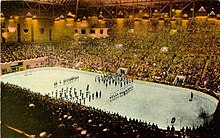
By 1930, Smythe saw the need to construct a new arena, viewing the Arena Gardens as a facility lacking modern amenities and seating.[36] Finding an adequate number of financiers, he purchased land from the Eaton family, and construction of the arena was completed in five months.[37][38]
The Maple Leafs debuted at their new arena, Maple Leaf Gardens, with a 2–1 loss to the Chicago Black Hawks on November 12, 1931.[38] The opening ceremonies for Maple Leaf Gardens included a performance from the 48th Highlanders of Canada Pipe and Drums.[39] The military band has continued to perform in every subsequent season home opening game, as well as other ceremonies conducted by the hockey club.[40][41] The debut also featured Foster Hewitt in his newly constructed press box above the ice surface, where he began his famous Hockey Night in Canada radio broadcasts that eventually came to be a Saturday-night tradition.[38] The press box was often called "the gondola", a name that emerged during the Gardens' inaugural season when a General Motors advertising executive remarked how it resembled the gondola of an airship.[42]
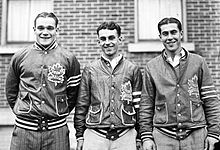
By the 1931–32 NHL season, the Maple Leafs were led by the "Kid Line" consisting of Busher Jackson, Joe Primeau and Charlie Conacher and coached by Dick Irvin. The team captured their third Stanley Cup that season, vanquishing the Chicago Black Hawks in the first round, the Montreal Maroons in the semifinals, and the New York Rangers in the finals.[43] Smythe took particular pleasure in defeating the Rangers that year. He had been tapped as the Rangers' first general manager and coach for their inaugural season (1926–27) but had been fired in a dispute with Madison Square Garden management before the season had begun.[44]
Maple Leafs star forward Ace Bailey was nearly killed in 1933 when Boston Bruins defenceman Eddie Shore checked him from behind at full speed into the boards.[45] Leafs defenceman Red Horner knocked Shore out with a punch, but Bailey, writhing on the ice, had his career ended.[38] The Leafs held the Ace Bailey Benefit Game, the NHL's first All-Star Game, to collect medical funds to help Bailey. His jersey was retired later the same night.[46] The Leafs reached the finals five times in the next seven years but bowed out to the now-disbanded Maroons in 1935, the Detroit Red Wings in 1936, Chicago in 1938, Boston in 1939 and the Rangers in 1940.[38] After the end of the 1939–40 season, Smythe allowed Irvin to leave the team as head coach, replacing him with former Leafs captain Hap Day.[38]
The first dynasty (1940s)[edit]
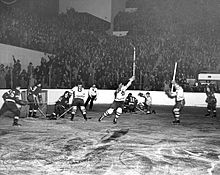
In the 1942 Stanley Cup Finals, the Maple Leafs were down three games to none in the best-of-seven series against Detroit. Fourth-line forward Don Metz then galvanized the team, to score a hat-trick in game four and the game-winner in game five.[47] Goalie Turk Broda shut out the Wings in game six, and Sweeney Schriner scored two goals in the third period to win the seventh game 3–1, completing the reverse-sweep.[48] The Leafs remain the only team to have successfully performed a reverse-sweep in the Stanley Cup finals.[49] Captain Syl Apps won the Lady Byng Memorial Trophy that season, not taking one penalty, and finished his ten-season career with an average of 5 minutes, 36 seconds in penalties a season.[50]
Smythe, who reenlisted in the Canadian Army at the outbreak of World War II, was given leave from military duty to view the final game of the 1942 finals. He arrived at the game in full military regalia.[48] Earlier, at the outbreak of war, Smythe arranged for many of his Maple Leafs players and staff to take army training with the Toronto Scottish Regiment. Most notably, the Leafs announced a large portion of their roster had enlisted, including Apps, and Broda,[51] who did not play on the team for several seasons due to their obligations with the Canadian Forces.[52] During this period, the Leafs turned to lesser-known players such as rookie goaltender Frank McCool and defenceman Babe Pratt.[52][53]
The Maple Leafs beat the Red Wings in the 1945 Finals. They won the first three games, with goaltender McCool recording consecutive shutouts. However, in a reversal of the 1942 finals, the Red Wings won the next three games.[52] The Leafs were able to win the series, winning the seventh game by the score of 2–1 to prevent a complete reversal of the series played three years ago.[52]
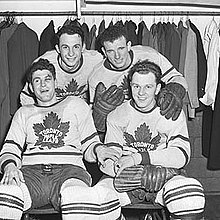
After the end of the war, players who had enlisted were beginning to return to their teams.[52] With Apps and Broda regaining their form, the Maple Leafs beat the first-place Canadiens in the
